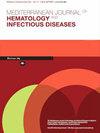急性白血病患儿导管端口感染的抗生素锁定疗法
IF 1.5
4区 医学
Q3 HEMATOLOGY
Mediterranean Journal of Hematology and Infectious Diseases
Pub Date : 2024-09-01
DOI:10.4084/mjhid.2024.072
引用次数: 0
摘要
导言导管为血液恶性肿瘤儿科患者施用化疗、抗生素、血液制品、液体和肠外营养提供了便利。然而,随着导管的广泛使用,导管相关的局部和全身感染已成为发病和死亡的重要原因。在我们的研究中,我们旨在评估抗生素锁定疗法在急性白血病儿科随访患者的端口导管相关感染中的成功率。方法回顾性评估了安卡拉市医院儿科血液学门诊在 2019 年 8 月至 2023 年 8 月期间随访的 182 名急性淋巴细胞/骨髓细胞白血病儿科患者的端口导管培养结果。结果在 182 名患者的 739 份端口导管培养标本中发现了细菌生长。由于端口导管相关感染,91 名患者需要关闭或移除端口,49 名患者需要移除端口导管。有 56 名患者的端口导管内有细菌生长,因此开始了抗生素锁定疗法。通过抗生素锁定疗法,42 名患者的端口导管相关感染得以根除,导管也可以重新使用。因此,在 56 名关闭端口并同时接受全身抗生素治疗的患者中,有 42 名(75%)患者的端口导管相关感染被根除,且未观察到感染复发。本文章由计算机程序翻译,如有差异,请以英文原文为准。
Antibiotic Lock Therapy for Port Catheter-Related Infections of Children with Acute Leukemia.
Introduction
Port catheters facilitate the administration of chemotherapy, antibiotics, blood products, fluid, and parenteral nutrition to pediatric patients with hematological malignancies. However, as its use has become widespread, local and systemic, catheter-related infections have emerged as important causes of morbidity and mortality. In our study, we aimed to evaluate the success of antibiotic lock therapy in port catheter-related infections of pediatric patients followed up with acute leukemia.
Methods
Port catheter cultures taken from a total of 182 pediatric patients with acute lymphoblastic/myeloblastic leukemia who were followed up at Ankara City Hospital Pediatric Hematology Clinic between August 2019 and August 2023 were evaluated retrospectively.
Results
Bacterial growth was identified in 739 port catheter culture specimens of 182 patients. Closure or removal of the port was required in 91, and removal of the port catheters in 49 patients due to port catheter-related infections. Antibiotic lock therapy was started in 56 patients with bacterial growth in the port catheter. With antibiotic lock therapy, port catheter-related infections of 42 patients were eradicated, and their catheters began to be used again. As a result, the port catheter-related infections of 42 of 56 (75%) patients whose ports were closed and also received systemic antibiotic therapy were eradicated, and no infection recurrence was observed.
Conclusion
Adding antibiotic lock therapy to systemic antibiotics in pediatric patients may be beneficial in terms of catheter salvage.
求助全文
通过发布文献求助,成功后即可免费获取论文全文。
去求助
来源期刊

Mediterranean Journal of Hematology and Infectious Diseases
Medicine-Hematology
CiteScore
4.20
自引率
6.20%
发文量
113
审稿时长
12 weeks
期刊介绍:
Reciprocal interdependence between infectious and hematologic diseases (malignant and non-malignant) is well known. This relationship is particularly evident in Mediterranean countries. Parasitosis as Malaria, Leishmaniosis, B Hookworms, Teniasis, very common in the southeast Mediterranean area, infect about a billion people and manifest prevalently with anemia so that they are usually diagnosed mostly by experienced hematologist on blood or bone marrow smear. On the other hand, infections are also a significant problem in patients affected by hematological malignancies. The blood is the primary vector of HIV infection, which otherwise manifest with symptoms related to a reduction in T lymphocytes. In turn, infections can favor the insurgency of hematological malignancies. The causative relationship between Epstein-Barr virus infection, Helicobacter pylori, hepatitis C virus, HIV and lymphoproliferative diseases is well known.
 求助内容:
求助内容: 应助结果提醒方式:
应助结果提醒方式:


